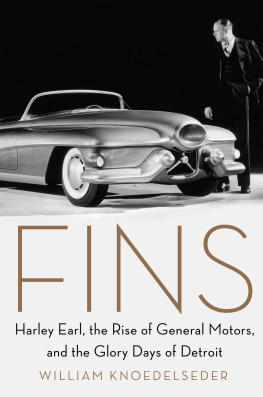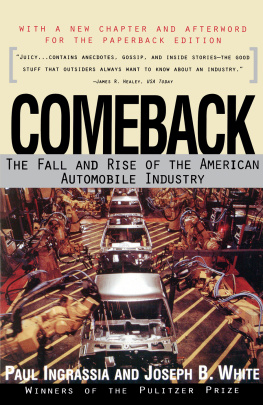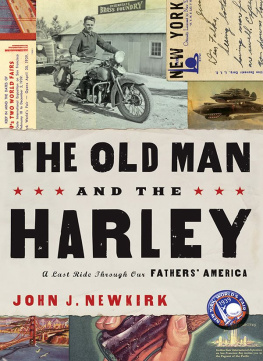In memory of my father, William Kenrick Knoedelseder Sr.,
and my dear friend for more than fifty years, Terry J. Cowhey,
the two guys who were always there to talk cars with me
It was D-day in Warren, MichiganMay 16, 1956. The invasion began at midmorning as an armada of automobiles, shuttle buses, and limousines materialized out of the mist all along Van Dyke Avenue and Mound Road several miles outside the city limits of Detroit.
The cause of the sudden traffic surge was General Motors, which was hosting an event for five thousand VIPs and members of the press to mark the official dedication of its new office complex, called the General Motors Technical Center, located on a mile-square plot of onetime farmland in the usually tranquil township of some forty thousand people.
The Dedication Day festivities were to include a sumptuous, chef-prepared picnic lunch, followed by a closed-circuit television appearance by President Dwight D. Eisenhower and a walking tour of the complex guided by CBS News reporter Walter Cronkite, whose network was set to transmit the event simultaneously to smaller-scale D-day gatherings at GM offices in sixty-one other cities.
That may seem like an awful lot of hoopla for a new office park, but the Technical Center was unlike any corporate facility ever before imagined. Built over a period of eight years at a cost of $125 million (the equivalent of more than a billion dollars today), it had been conceived by a trio of senior GM executives as a melding of science, technology, and art that would stand as a testament to the seemingly limitless capability of both the company and the country, a lofty ambition that appeared to have been achieved with the finished product.
Twenty-five sleek, low-slung buildings made of steel and glass, the material of automobiles, were set in a lavishly landscaped 330-acre campus surrounding a 22-acre artificial lake accented by four islands of weeping willow trees, a 138-foot stainless-steel water tower, and two dramatic fountains, one spraying a shimmering curtain of water 50 feet high and 115 feet wide and the other, designed by famed sculptor Alexander Calder, shooting twenty-one streams into the air, pulsing, leaping, and falling in a graceful liquid ballet.
A GM press release boasted that the two fountains displaced more water than all the fountains at Frances famed Palace of Versailles, prompting Life magazine to proclaim the Tech Center the Versailles of Industry.
Clustered around the lake, offices for the companys four major staff operationsmanufacturing, engineering, research, and stylingwere demarcated by decorative exterior walls of brilliantly colored glazed brickscrimson, scarlet, tangerine, royal blue, lemon yellow, chartreusereminiscent of those found in the palaces of ancient Abyssinian kings (again, according to a GM press release). Because no contemporary commercial brick maker possessed the technical know-how to meet the architects specifications, the bricks had been glazed and baked in a giant kiln that GM financed specifically for the task.
The focal point of the Tech Center was the Styling Auditorium, with its gleaming aluminum-covered dome mirroring the sky. Aside from being visually stunning, the 65-foot high dome was a technological marvel, the first of its size to be held aloft by pressure-vessel construction, which basically inflated it from within. The 188-foot span consisted of welded sheets of steel a mere three-eighths of an inch thickin relation to its total area, as thin as one-thirtieth of an eggshell.
Given an advance look at the facility, Architectural Digest pronounced it an architectural feat that may be unique in our time.
As it turned out, the fancy picnic had to be moved under a huge tent because of the weathera stiff, cold wind and an intermittent drizzle that weather forecasters warned might turn into a full-blown thunderstorm before the day was out. Luckily, however, the rain failed to arrive as predicted, and shortly before noon the guests began filing into the open, drafty bleachers that had been set up on the west side of the lake opposite the engineering buildings. Bundled against the chill in overcoats, hats, and gloves, the assemblage represented a sizable portion of Americas postWorld War II brain trust: Wall Street bankers, CEOs of manufacturing firms, presidents of universities, deans of engineering schools, scientists, inventors, architects, philanthropists, government officials (notably, Secretary of Defense Charles E. Wilson, a former president of GM), and senior officers from all branches of the military, including the vice commander of the Strategic Air Command, the chief of the navys bureau of ordnance, and the armys chief of research and development. Typically for the time, almost all were men; it was nearly impossible to find a female face in the crowd.
After Cronkite explained the wonders of the new closed-circuit-TV technology, a military band played The Star-Spangled Banner and four F-86 Sabre jets executed a screaming low-level flyover punctuated by the detonation of an aerial bomb. Harlow Curtice, the GM president and CEO, stepped to the podium and declared, We have gathered here today for a momentous occasion.
That wasnt exactly true. The Tech Centerwith its four thousand scientists, engineers, technicians, and designershad been operational for more than six months. So the occasion was really an elaborate bit of public relations. But the moment was indeed significant. As the sun began to peek through the clouds that November-like day in May, America was at its apexthe dominant military, economic, and social force on earth. General Motors reigned as the most successful company in the history of business. Detroit was the manufacturing capital of the world and home to the industry that directly or indirectly employed one in six Americans.
No industry has contributed more to our nations growth and development than the automobile industry, Curtice said. Its product has completely changed the face of America and the lives of all Americans.
Curtices preeminence on the program was made possible by the retirement the month before of Alfred P. Sloan Jr., who had headed GM for thirty-three years and whose organizational brilliance was universally credited with shaping the company into a global colossus. The Tech Center had been Sloans idea. He was sitting a few feet away from Curtice but had chosen not to speak.
Charles F. Kettering, GMs vice president and director of research from 1920 until his retirement in 1947, followed Curtice to the speakers stand. Now nearing eighty, Boss Ket, as he was affectionately referred to around the company, was a legend in the auto industry. A scientist, engineering genius, and inveterate inventor with more than 140 separate patents in his name, he revolutionized the car business in 1912 when his electronic starter replaced the old arm-busting crank starter, which had served as a barrier to women becoming independent drivers.
Sloan and Kettering had built GM together, had grown rich and become philanthropists together, founding the Sloan-Kettering Institute for Cancer Research in 1945. They had also planned the Tech Center together, beginning in the years before the war. But in a rare divergence, they ended up disagreeing strongly about how it should look. Kettering thought most of what passed for modern architecture appeared frivolous, frail, and poorly constructed. He preferred a classic ageless look. GM didnt need any fancy buildings, he told Sloan. We want solid, functional buildings that dont detract from what we do in them.
Twelve years after that conversation Boss Ket still seemed a bit miffed that Sloan, the real boss, had overruled him. One thing worries me about this Technical Center, he said. Im afraid that the people here may lean too heavily on the facilities and forget that ideas are developed in the mind. If we took all the people away it would be obvious that nothing would come out of the Technical Center.
Next page









